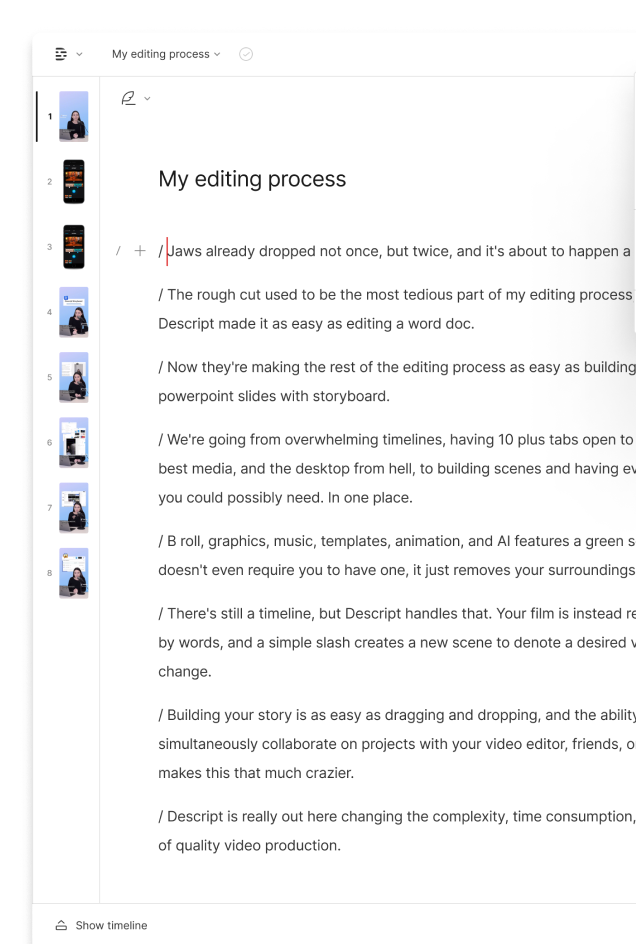What type of content do you primarily create?




When you first sit down to write a script, whether it be for a film, podcast, or vlog; fiction or documentary; the first thing you should ask yourself is “What’s the story?”
A story is the very best way to hook your audience and immerse them in your script. Our brains are wired for story. From cave art to TikTok, we’ve shared information through storytelling for millennia.
But it’s easy to get confused over what counts as a story and what’s just a series of events.
At the heart of stories lie characters. Incidents and events (aka plots) emerge out of who your characters are.
Whether you’re a filmmaker or podcaster, the following five strategies will help ensure your plots are fully realized through character, without falling prey to predictability.
Character drives action (not the other way around)
When you lead with character, the events in your story follow a logical progression without being predictable. Because the decisions the characters make stem from who they are as people, the audience understands those decisions, even while being surprised by them.
 |
Here’s an example of action leading the story:
They went for a drive. They saw a sign that said “Call the number below”. They did. It changed their lives forever.
Who are they? Who answered the call? What did they say? Changed their lives how?
Here’s what happens when you switch it to character driving the action:
“There’s a billboard I want to show you,” said her mom. “It’s got a number on it I want you to see.”
She hadn’t seen her mom since her sister went missing. It was too difficult. She was surprised when she received a text from her mom inviting her to go for a drive. It was the last thing she wanted to do, but couldn’t find the words to say no.
Now I’m interested!
Find the character’s irrationality
In The Science of Storytelling, journalist and author Will Storr describes a conversation with famous psychologist Jonathan Haidt about storytelling. Haidt’s career has largely focused on moral emotions.
According to Haidt, storytellers need to “follow the sacredness. Find out what people believe to be sacred, and when you look around there you will find ‘rampant irrationality.’”
Rampant irrationality, according to Haidt, is what makes for a good protagonist—a lead character that must learn to overcome, either externally or internally, the problem that the plot poses.
Okay, but how do you locate the thing a person is irrational about?
In nonfiction films and podcasts, you can just ask your character.
For example, this morning in an interview I conducted for a piece about child protection, my interviewee said, “The most sacred thing to our community is our children. They are our future, our inheritance.”
They said this naturally, which made my job nice and easy. But you can broach the question in a number of ways. “What is it that keeps you up at night?” “Why is this thing so important to you?” “What would happen if this thing was taken away from you?”
Eventually, you’ll get to a person’s sacred belief, something they’ll do anything for.
Don’t fall in love with your protagonist
When you recognize a good protagonist, whether in film or podcasting, fiction or nonfiction, it’s important to remember they’re not perfect.
It can be exciting to interview someone you admire, but placing a person on a pedestal is dangerous because you lose sight of their inevitable flaws. Flaws are what make people, and characters, interesting. Without them, there’s no conflict to drive the story forward.
Round and flat characters
Fiction theorists say that fully crafted protagonists are round, not flat.
A flat character might have only one characteristic and exists only to display it. A round character is complex and, importantly, capable of change.
“Human beings are the sum of their values, beliefs, behaviors, and possessions”, says writing coach and Pulitzer Prize winner Jack Hart in his book Story Craft.
Before you begin your script, take time to fully understand your characters as people. It might even be useful to understand their personality type with a personality test like the Myers-Briggs Type Indicator (MBTI).
The more context and detail you understand about your protagonist, the more successful and relatable your protagonist, and story will be.
It’s in the detail
Beyond understanding motivation and personality, we can learn a lot about a character by the way they look, move, speak, and carry themselves.
 |
Physical appearance
It’s difficult to imagine what’s going on in a scene without picturing what a character looks like. For film, it’s easy, though be aware that what your character wears counts. A character in joggers will be viewed differently to a character in a business suit.
For narrative podcasters, consider describing your protagonist's physical appearance. Let the listener visualize the character, as they would in a film or in person.
Movements and mannerisms
Body language provides a huge amount of information. When faced with another human, we naturally attempt to read body language. Folded arms, tense shoulders, fiddling — it all tells us something about how a person might be feeling.
Don’t discount movements and mannerisms in storytelling. It’s an easy way to communicate something to your audience. If you’re told to project confidence, you’ll straighten your shoulders and sit up tall, just as you might slouch and lean if you’re told to look tired or indifferent.
Speech
It’s probably obvious that what a character says is important to a story. But how they say something can be even more revealing than the content of their words.
In documentary, the moments you choose to show your character describing an event or interacting with other people can change the entire story. And a lot of that has to do with their speech: the crack of a voice in the middle of a stoic retelling of a traumatic event, a thick accent in an immigration story, a husky laugh among friends—they all tell more than words on a page.
Action isn’t enough. A compelling script is all about character. By embracing the sacred beliefs that drive individuals, creating or recognizing complex “round” characters, and hyper-focusing on softer details, storytellers can avoid cliché and predictability, breathing life into their character-driven stories.








































%20(1).JPG)





